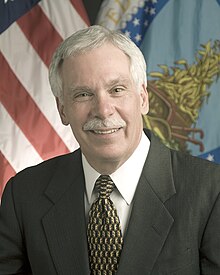Ed Schafer
Thomas Edward "Ed" Schafer (* 8. August 1946 in Bismarck , North Dakota ) is an American politician of the Republican Party . He was from 1992 to 2000 Governor of the State of North Dakota, and from 2008 to 2009 Minister of Agriculture in the cabinet of US President George W. Bush .
Early years and political beginnings
Ed Schafer attended the University of North Dakota until 1969 and then the University of Denver . After graduating, he worked in his father's handicraft company, of which he was director between 1978 and 1985. Schafer began his political career in 1990 when he ran for the US House of Representatives and achieved a respectable success with 35 percent of the vote against the Democrat Byron Dorgan .
North Dakota Governor
In the gubernatorial elections in North Dakota, he was not the favorite after the resignation of popular incumbent George Sinner . However, there was an internal party primary between the Democrats ' two opposing candidates , Attorney General Nicholas Spaeth and Senate President William S. Heigaard. Heigaard initially won at the party convention, while Spaeth, an anti-abortionist and supporter of government investment in economic development, won the June 1992 primaries with 65:35 percent.
Economic development was the central issue in the elections. Spaeth, who promoted the state growth plan ( Growing North Dakota Plan ), accused Schafer in the election campaign of taking advantage of loans and tax cuts based on this plan for his own economic interests. Schafer, on the other hand, campaigned for municipal and private economic development. In the election, Schafer achieved an impressive majority of 58 percent compared to Spaeth, who received only 41 percent of the vote. Schafer was able to win in all major cities and in 40 of the 47 electoral districts. In addition, he received 60 percent of the votes among voters under 60, while Spaeth received 55 percent of the votes among voters over 60. Schafer succeeded George Sinner as governor of North Dakota.
After two years in office, he pursued a policy of tax cuts and a "lean government" ( Rightsizing Government ). He received broad recognition for creating 15,000 new jobs and increasing the population for more than a decade. The Republican Party not only won state elections in 1994, it also won control of the State Senate. Schafer became increasingly popular and received when he was re-elected governor in 1996 with 66 percent of the vote, an overwhelming majority over Democratic Senator Lee Kaldor . In 2000 he was replaced as governor by his fellow party member John Hoeven .
Further career
Schafer refrained from running against US Senator Byron Dorgan in 2004 , despite leading Republicans urging him to run in that election. In January 2008, he was nominated by President Bush to succeed Agriculture Secretary Mike Johanns . Kent Conrad , the second Democratic US Senator from North Dakota, called for an earlier Senate hearing to allow Schafer to attend the State of the Union Address as a cabinet member. This became possible after the Senate unanimously confirmed his appointment.
After the inauguration of the new President Barack Obama , Schafer was replaced by Tom Vilsack in January 2009 .
Web links
- Biographical notes in rulers.org (English)
- Ed Shafer in the National Governors Association (English)
- North Dakota Historical Society (English)
- Ed Schafer at the Miller Center of Public Affairs at the University of Virginia (English)
| personal data | |
|---|---|
| SURNAME | Schafer, Ed |
| ALTERNATIVE NAMES | Schafer, Edward Thomas |
| BRIEF DESCRIPTION | American politician |
| DATE OF BIRTH | August 8, 1946 |
| PLACE OF BIRTH | Bismarck , North Dakota |

